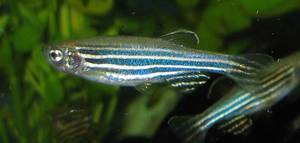Human Hormones Feminising Fish - Planet Earth Online
Interview with
What happens to the hormone disrupting chemicals found in contraceptive pills or hormone replacement therapies once they've passed through the body?
Well, they end up in the sewage system and eventually as effluent into the rivers. But it seems many of these chemicals are still active and they've having an effect on fish.
Planet Earth Podcast presenter Richard Hollingham has been talking to Charles Tyler from the University of Exeter, a world expert on the problem...
Charles - One particular group of chemicals that we've been focused on are chemicals called oestrogens, or environmental oestrogens and these are chemicals that can mimic and copy the body's hormone oestrogen, which is a female sex hormone. And these oestrogens include natural steroid oestrogens derived from women, derived from the human population; they include contraceptive oestrogens, from the contraceptive pill. Also, actually, things like horse oestrogens, equine oestrogens, which are used in hormone replacement therapy, and then in addition to that they also include chemicals that copy and mimic the structure of those natural steroid oestrogens, so various industrial products.
 Richard - Now, we're in one of your aquarium labs at the University of Exeter and surrounded - well floor to ceiling - by transparent tanks full of, well, beautifully colour zebra fish zipping backwards and forwards, and they're called zebra fish because they have these stripes running horizontally along them and each one, I suppose, I can't really measure them because they are going so fast are about 2 cm long.
Richard - Now, we're in one of your aquarium labs at the University of Exeter and surrounded - well floor to ceiling - by transparent tanks full of, well, beautifully colour zebra fish zipping backwards and forwards, and they're called zebra fish because they have these stripes running horizontally along them and each one, I suppose, I can't really measure them because they are going so fast are about 2 cm long.
Charles - These are one of the key model species we now use to try and help us understand how some of these chemical I mentioned, how they work in the body. Because we know now from studies on wild fish that they're being affected by these chemicals that are being discharged, they're being feminised, males are being feminised essentially. And so one of the big questions that we're trying to address in relation to the use of the zebra fish is how and where these chemicals work in the body.
Richard - And you say they're being feminised, what do you mean by that?
Charles - That males are showing traits or characteristics which are normally found in females. So defining feminisation in fish includes they're producing proteins which are normally only found in females, the yoke proteins, for example, which normally go into the eggs. They include alterations in structures within the testes so the male gonad. They include, in particular, the presence of developing eggs within the testes so quite unusual phenotypes and quite unusual effects are being seen in the fish as a consequence of exposure to these oestrogens.
Richard - Now these zebra fish in here are not ordinary zebra fish. These are engineered to help you with the work?
Charles - Absolutely. These aren't native to English rivers and we're using these very much of a model to try, as I say, to understand how chemicals work in the body. And this is some work that Tetsuhiro Kudoh, a colleague, and myself have been developing over time to help us understand where these chemicals work in the body. So, these are what we call transgenic fish and essentially there's some clever little genetic constructs have been placed into these fish in turn which then produce a green florescence, they glow green essentially, in target tissues which are receiving and responding to these environmental oestrogens.
 Richard - Now if you're a male fish feminisation sounds like a bad thing, but not necessarily and this is what you're investigating now.
Richard - Now if you're a male fish feminisation sounds like a bad thing, but not necessarily and this is what you're investigating now.
Charles - Absolutely. So our concern really has been that we find this widespread feminisation of fish in English rivers but we don't know whether it's causing effects at a level of the population. Now it matters if you're an individual fish and you are feminised because you have a reduced capability to breed but does that really matter from the point of view of population? When we think about protecting the environment, we don't protect at the level of the individual for wildlife like we do for human health, we protect at the level of population. So some of our parallel work now is trying to address whether there are changes in the populations of wild fish living in English rivers.
Richard - And how do you go about doing that at a population level? You can see these zebra fish in the tank and you can see if they've got this florescence so they're being feminised but how do you take that next step?
Charles - Addressing the population level consequences of something like this is an extremely difficult and challenging question to address. In fact there are very few examples for any chemicals discharged into the environment where you can assure population level effect and link it to a specific chemical. The way we're going about it is we're trying to address whether there has been changes in the genetic structure, changes in the genetics of wild populations and we're doing this by comparing those genetics of fish in the more polluted rivers compared to those in cleaner environments. So, we're using specific genetic tools to help us identify if the populations have changed.
- Previous What is Ash Dieback?
- Next Finding and Fighting Bed Bugs










Comments
Add a comment